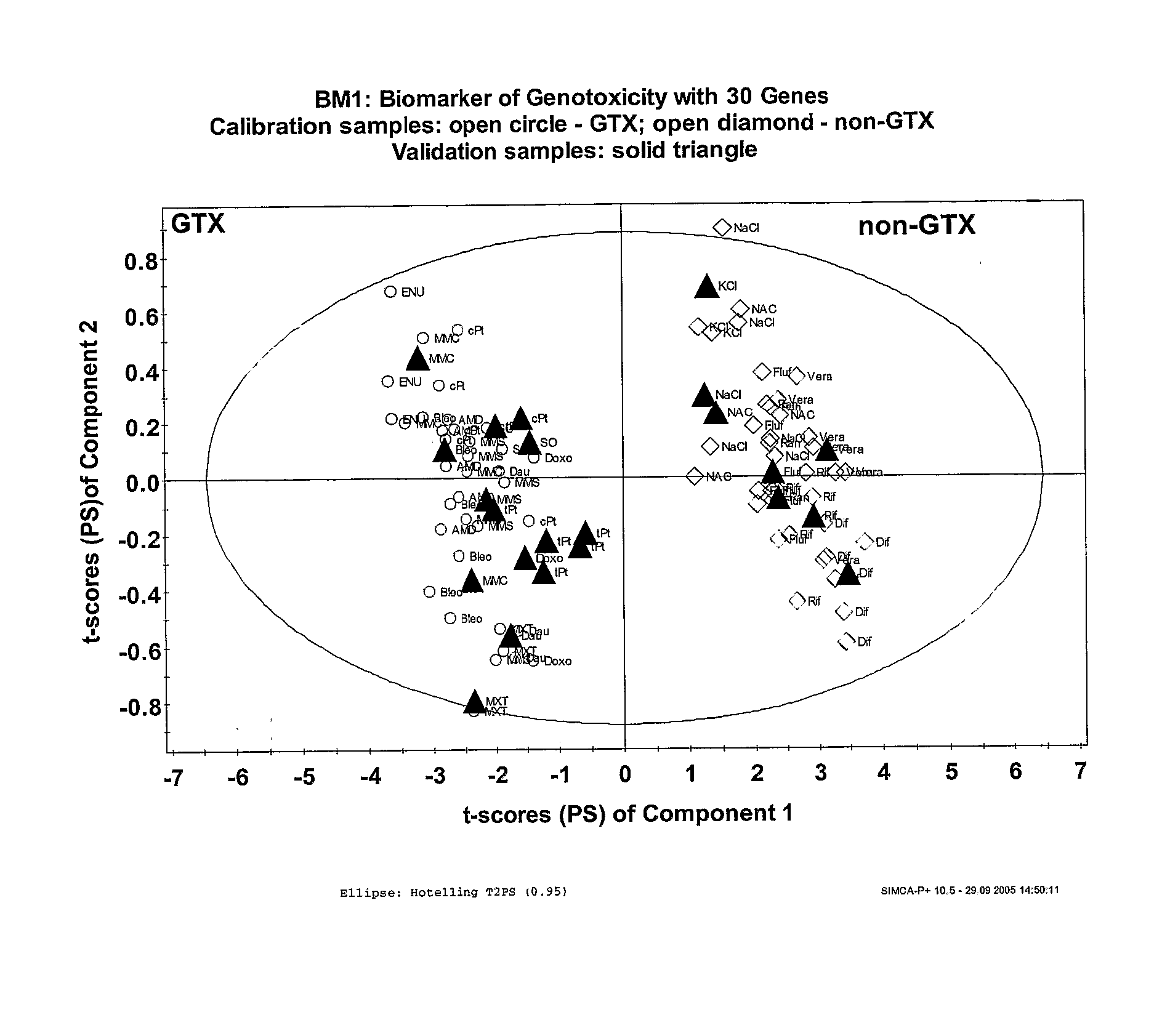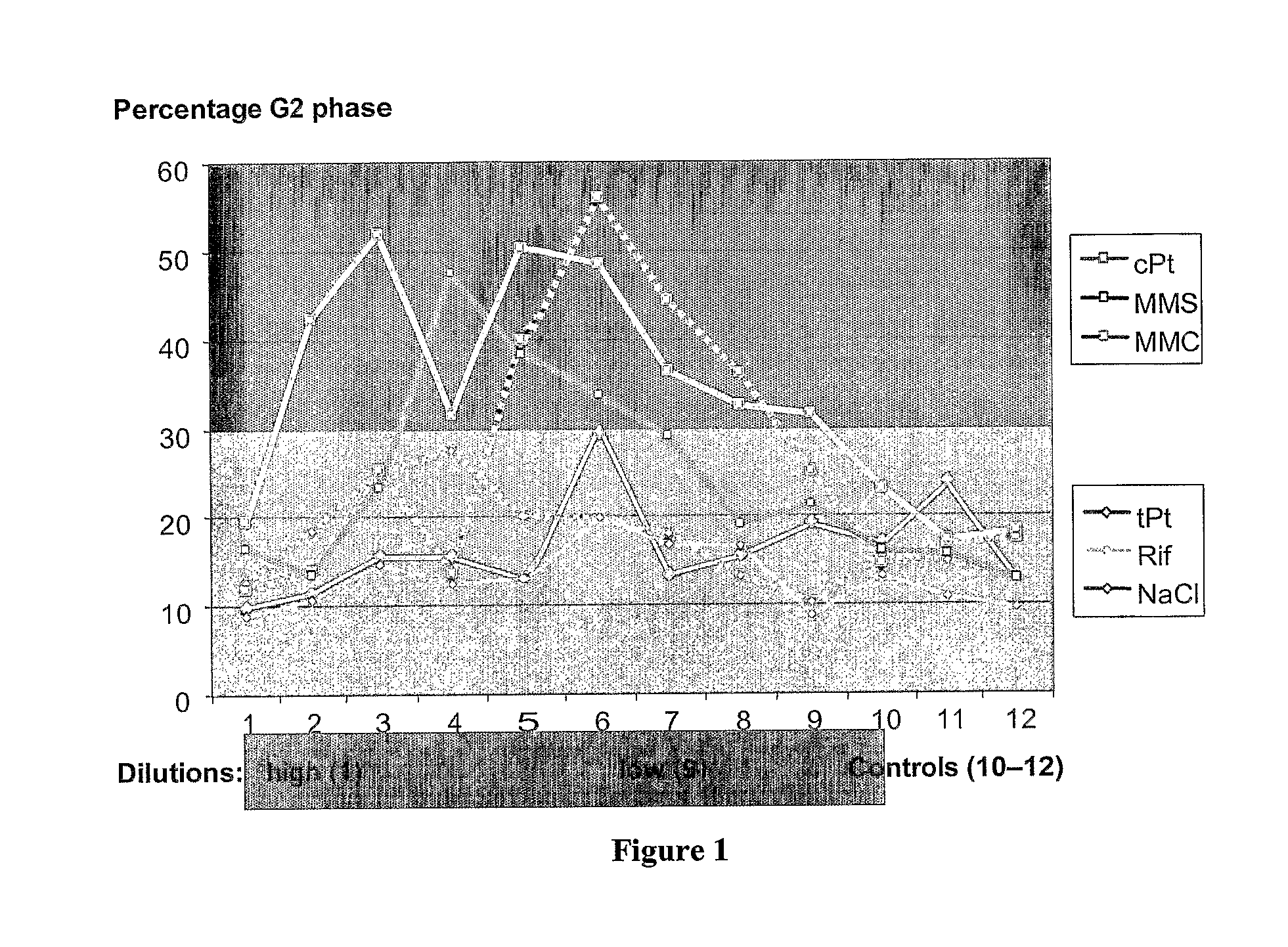Evaluation of the Toxicity of Pharmaceutical Agents
a technology of toxicity and pharmaceutical agents, applied in the field of toxicity evaluation of pharmaceutical agents, can solve the problems of requiring a large number of laboratory animals, affecting the accuracy of drug candidates' results, etc., and achieves the effect of rapid high-throughput screening process
- Summary
- Abstract
- Description
- Claims
- Application Information
AI Technical Summary
Benefits of technology
Problems solved by technology
Method used
Image
Examples
example 1
Determination of Cytotoxicity and G2 Phase Block
[0145] The six model compounds identified in Table 1 were applied in a dilution series to TK6 cells. The resulting dilution series for each of the six compounds provided individually optimized cytotoxic concentrations for 50% cell death (EC50) as determined by cell density and the Alamar Blue assay. These data are shown in FIG. 1 and Table 2. It is possible that cell density and the Alamar Blue assay may not give identical cytotoxicity profiles. Thus, concentrations of the compounds were optimized with the objective to have both cytotoxicity parameters within the range of 40-60% viability decrease. In addition, for representative dilution series several cytometry endpoints were analyzed (BrdU incorporation, KI-67 staining (Histogenex, Edegem, Belgium), propidium iodide staining), although these parameters were not used for concentration selection.
TABLE 2Cell DensityAlamar BlueClassCompounds or Drugs(±S.D.)(±S.D.)Non-genotoxictrans-P...
example 2
Identification of Candidate Predictor Genes
[0148] For experiments leading to hybridization of RNA to human genomic probes, concentrations of the compounds as specified in Table 1 were used (Example 1). These concentrations are equicytotoxic (e.g., cPt: 1.3 μM, and tPt: 33 μM). Each compound was tested using six independent replicates on two or three different dates. After isolation of total RNA expression profiles were compiled using Affymetrix HGU133A PLUS 2 microarrays
[0149] As noted in Materials and Methods, one vehicle, three cytotoxic reagents and three genotoxic reagents were used to treat TK6 cells. Each of the replicate samples was applied to an Affymetrix HGU133A chip for hybridization and detection of the results. These data were filtered for fold-change, signal mean, and signal CV as described in Materials and Methods. Only 215 genes passed this rigorous filter process. These filtered genes are compiled in Table 3.
TABLE 3215 GENES FROM FILTERINGLOCUS-LINKGENBANKREFSEQ...
example 3
Identification of Highly Predictive Genes Using PLS-DA
[0153] Partial least squares discriminant analysis (PLS-DA) was applied to the set of 215 candidate genes identified in Example 2. This analysis provides the discriminant function that best separates the cytotoxic and the genotoxic compounds. The score plot of the first component t[1] based on these 215 genes is displayed in FIG. 4 which shows a good separation between the two classes of compounds, with each sample for NaCl, Rif, and tPt above or at t[1]=0, and all samples for cPt, MMC, and MMS below t[1]=0. However, two samples of the cis-Platinum group are located quite closely to the trans-Platinum samples. The investigation of the differential gene pattern by PLS-DA revealed 23 genes that contribute most strongly to the distinction between the cytotoxic and genotoxic samples. These genes are compiled in Tables 5A and 5B together with their means, coefficient of variation, fold-change and p-value of students t-test.
TABLE 5A...
PUM
| Property | Measurement | Unit |
|---|---|---|
| temperature | aaaaa | aaaaa |
| pH | aaaaa | aaaaa |
| pH | aaaaa | aaaaa |
Abstract
Description
Claims
Application Information
 Login to View More
Login to View More - R&D
- Intellectual Property
- Life Sciences
- Materials
- Tech Scout
- Unparalleled Data Quality
- Higher Quality Content
- 60% Fewer Hallucinations
Browse by: Latest US Patents, China's latest patents, Technical Efficacy Thesaurus, Application Domain, Technology Topic, Popular Technical Reports.
© 2025 PatSnap. All rights reserved.Legal|Privacy policy|Modern Slavery Act Transparency Statement|Sitemap|About US| Contact US: help@patsnap.com



